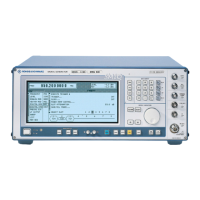Digital Standard 3GPP W-CDMA (FDD) SMIQ
1125.5555.03 E-92.224
PRACH and PCPCH consist of preambles and the message part. Similar to a P-CCPCH, the preamble
uses the 4 constellation points (2, 0), (0,2), (-2, 0) and (0, -2). In the case of the message part, separate
powers can set for Data (on the I path) and Control (on the Q path) so that a component is obtained as
described above for the DPCCH+DPDCH signal. As the third part of the constellation, points can be seen
at the origin, which can be assigned to the interval between preamble and message part:
Fig. 2-144 Constellation of a PRACH
Envelopes
To eliminate smearing of the amplitude due to the root-cosine filter, all envelopes are calculated using a
square-wave filter. The DPCCH and the DPDCHs are continuous channels that feature a constant
envelope during the complete sequence.
Note: Section 2.14.2.6 "Misuse TPC for output power control", describes how to vary also the
envelope of DPCCH and DPDCHs.
PRACH and PCPCH consist of one or several preambles and the message part.
Example of a PRACH with a preamble and reduced power in the message part:
Fig. 2-145 Envelope of a PRACH
Example of a PCPCH with the parameters
• Access Slot # = 0
• Preamble Repetition = 4
• Preamble Power Step = 1 dB
• Message Part Length = 1 frame
• Preamble Power = 0 dB
• Control Part Power = 0 dB
• Data Part Power = 0 dB
Fig. 2-146 Envelope of a PCPCH

